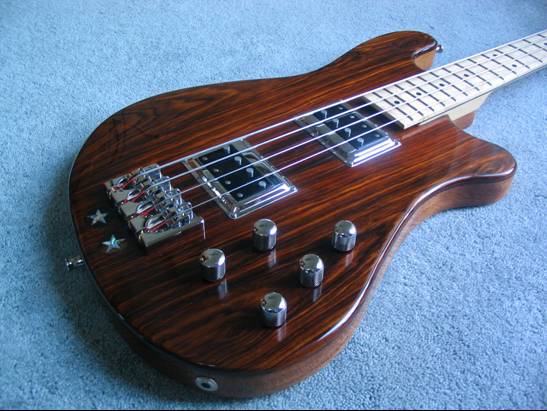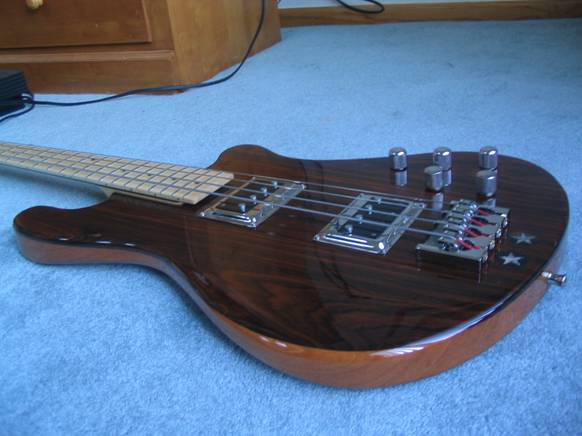| Author | Message | ||
| bassman10096
Senior Member Username: bassman10096 Post Number: 879 Registered: 7-2003 |
Hi everybody: A few of you may remember that a while back, I had a truly wonderful custom cocobolo S2 built (http://alembic.com/club/messages/411/12133.html?1094104551). Gold hardware, inlaid logo, continuous backplates, pretty much everything I ever thought of to want. Well, a year later, my son got accepted to NYU and tuition money became my major priority (at least he didn't make me an unexpected grandpa - so things could have been worse - LOL). Unfortunately, my baby had to be found a new, loving home (with a Club member). It was one of the hardest car rides in my life to meet the lucky guy who was buying my Alembic. But while I was in the car, inspiration struck! I had been hacking around with refinishing and modifying basses. I was looking for a project to build a body and add a neck I bought somewhere else. By pure coincidence, that same week I'd stumbled across a wood supplier who would glue up and sell me a body blank laminated from - 1/4" of cocobolo over mahogany. To make a very long story short, I had also had a wicked jones for a graphite necked bass. I love the harmonics (low fundamentals, especially) and sustain. The closest I had come to the sound I liked was a Modulus Genesis with a maple board and Bart pu's and preamp. But it still suffered from the typical complaints about graphite (kind of sterile sound, shrill highs, lacking in real mids, etc.) How to make that bass a better bass? Inspiration (and an unhealthy desire for death-wish design risks) struck again! Maybe there was a way to dim the loss of all the cocobolo I was used to holding every day AND to build the graphite bass I wanted. I tracked down a Genesis J replacement neck, ordered the coco/mahog body blank and concocted the electronics package - Dark Star pu's and a Bart NTMB preamp. To make what was by now a long (and probably boring) story a little shorter, all that remained was to design a body shape. Harder than I thought is all I can tell you. I wanted a retro look. After endless study of Jazzmasters, old P's, Mustangs, Gibsons, Alembics and lots of others, I found myself looking at ancient Teiscos and Ekos (think DEEPLY retro) - what we might call real “ho's". By dumb luck, I actually found a 1962 Eko Cadet in my luthier’s shop. A little tracing and pencil modifications later and I was done.. After this - lots of woodworking and learning to get a finish to stick to cocobolo (not easy - I went with nitro) and learning a bit about inlaying. Not the most distinguished or figured piece of cocobolo (by Alembic standards), but the coloring was nice and I fell in love with it (can you find the eagle’s head?). I also found and just had to add a non-matching, but really bizarre piece of cocobolo for the backplate. I learned an ton and had lots of fun doing the building. It came in on the heavier side (10.5 lb. curb weight). I had to thin the body to 1.5” to get it down (the 1.75” thick coco/mahog body blank weighed 25 lb before I cut the body out of it). But it’s currently wearing my Moody/Alembic 4” strap and isn’t hard to have on for 3-4 hours. Plus the body contours are pretty slim, making it handle better than my other basses. Well, I always intended to share it with you folks, so…Welcome to the grand unveiling of my “Cocobolo Consolation Bass”:     A monthly special it’s not, but it sounds like heaven strung with TI JFs. Gutsy/gritty and downright mean with the neck pu soloed. Really sweet, with ultra articulate highs with the electronics balanced. The mahogany tightens up the “blasty” character of the lows but leaves them warm and round (sounds great through my ELF 18”). Highs just sing – no harshness. And a perfect match for my SF-2. It’s not an Alembic (I still plan to own another) but, as science experiments go, a success. This is definitely (if I do say so myself – and I do) the best graphite necked bass I’ve heard or played. Now, maybe a 5 string version? Many thanks to Paul Ellsworth (TGO) for his invaluable technical and woodworking advice (Yes, you can clean your teeth with a spindle sander!). Bill | ||
| 811952
Senior Member Username: 811952 Post Number: 710 Registered: 10-2003 |
Nice! It's pretty cool to build an instrument yourself and gig with it! John | ||
| crgaston
Intermediate Member Username: crgaston Post Number: 175 Registered: 11-2005 |
Excellent work, John! | ||
| jlpicard
Senior Member Username: jlpicard Post Number: 420 Registered: 7-2002 |
Very nice ! I like the look of those Dark Star pups! Very retro. And a pleasing body shape too! You've just inspired me to get off my butt and finish some of my bass projects. By the way, I didn't know you could still buy Modulus replacement necks. Mike (Message edited by jlpicard on April 17, 2006) | ||
| zuperdog
Junior Username: zuperdog Post Number: 34 Registered: 11-2005 |
Nice! | ||
| bassman10096
Senior Member Username: bassman10096 Post Number: 880 Registered: 7-2003 |
Thanks. Once I decided to go with the Dark Stars, it had to be retro. They look kind of like little chrome 1950's TV sets or toasters or something. And they are definitely on the big side - Makes em look sort of diesel/industrial strength (which they are). I'm still settling in with the bass. I've got to shim the pu's about 1/8" to bring the coils a little closer to the strings (to fit manufacturer clearance specs). They are very high output, so this will probably give things a little more punch. Actually, the output is so high that I just realized tonight that I had not changed my rig volume and I was running the master volume on the bass at about a 2. I think that will give me a little extra leeway to run the power amp at about a 1 and the preamp gained up and hot or vice versa. On the Modulus neck - they do still make regular (full graphite) and Genesis (graphite, load-bearing spar with wood fit around it)replacement necks. But they now only make the Genesis necks in maple back/maple board. The other thing I'm noticing is that the fingerboard is just a little wider than standard J and the back profile is slimmer. I was not sure I'd like the maple board (it was all I could get) because my old maple board Fender J was just too bright for my liking. For some reason, the combination of the pu's, the TI's and maybe the preamp seem to undo that effect. Instead, the maple just feels nice and slick. The string spacing and back profile make for a really nice feel to holding the board and strings. That's also enhanced by the even volume of notes across the board. Definitely a different feel from most necks, but nice. A little like my Alembics, in that you do want to finger notes accurately, but not so much that it feels fussy. Bill (Message edited by bassman10096 on April 17, 2006) | ||
| davehouck
Moderator Username: davehouck Post Number: 3646 Registered: 5-2002 |
Nice! | ||
| richbass939
Senior Member Username: richbass939 Post Number: 616 Registered: 11-2004 |
Seeing this has inspired me on my own home-build project. Beautiful bass. Rich | ||
| bassman10096
Senior Member Username: bassman10096 Post Number: 883 Registered: 7-2003 |
Thanks. Go for it, Rich. I was surprised at how doable it turned out to be. Just as a for instance, rather than going the whole band-sawing route for cutting out the body, I rough-cut the outline with a sabre, then sanded the outline exactly to the line with a $75 spindle sander (the woodworker's secret weapon). Plus a router (I let my luthier route the neck pocket for $35, cause I was nervous), assorted Dremel tools and lacquer and finishing supplies from Reranch.com, it didn't cost or involve very much tooling. There are lots of other carving techniques and tools, but I found it pretty easy to keep it simple yet still be able to carve the lines and contours I wanted (without sacrificing design). P.S. - I am not particularly "handy" or skilled - just willing to think things through and take my time. (Now, back to our regularly scheduled program...) |